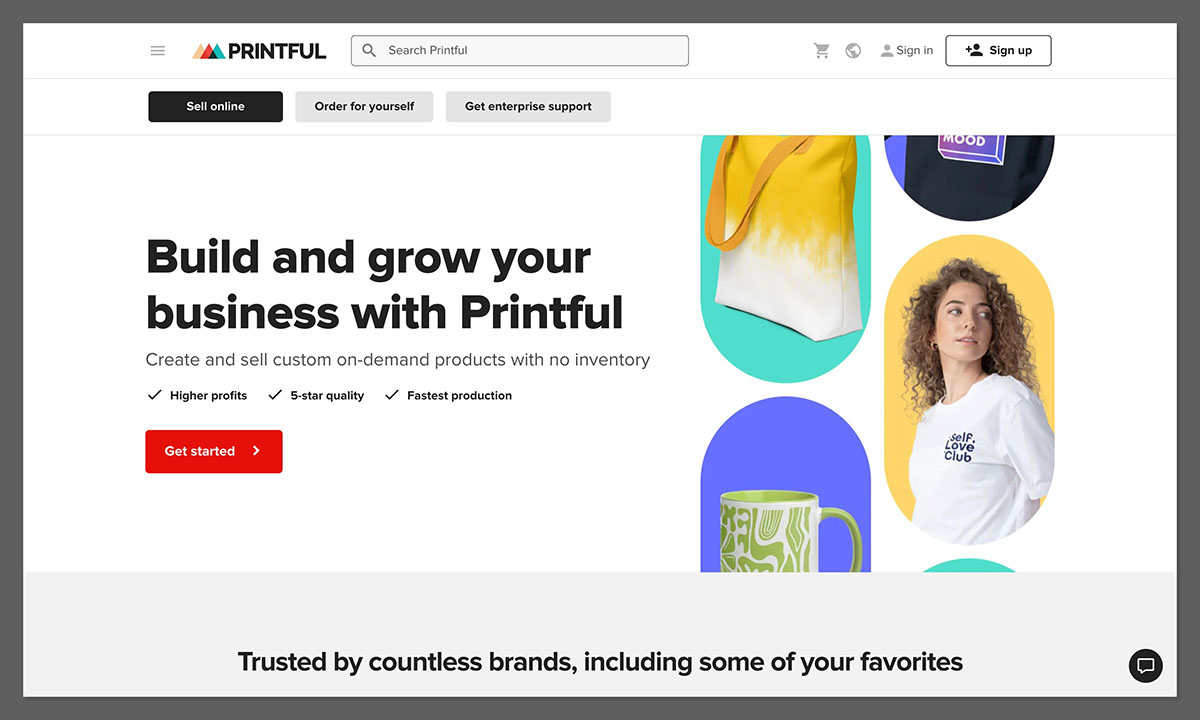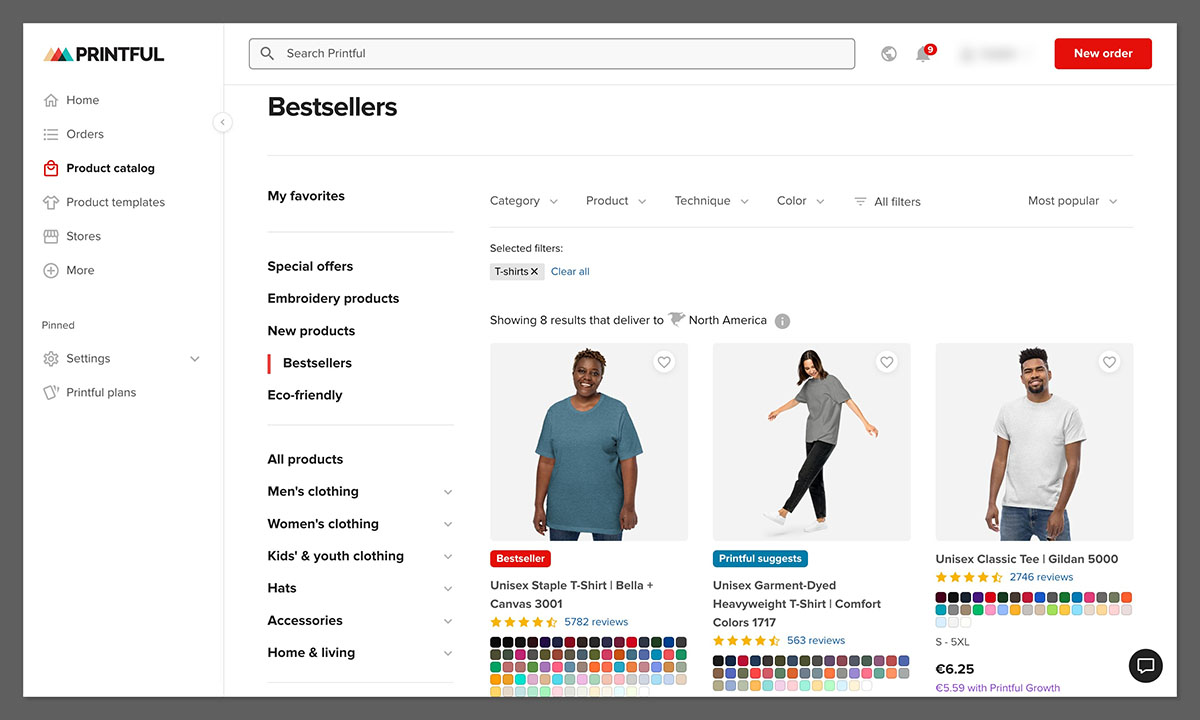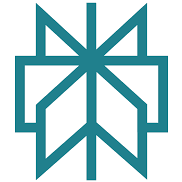If you’re thinking about starting a t-shirt business but don’t want to deal with inventory, printing machines, or packing orders yourself, drop shipping with Printful is a solid option.
I’ve been in the print-on-demand game for over a decade, and Printful is still one of the best platforms out there if you want to build a streamlined business that scales without major upfront costs.
In this guide, I’ll walk you through exactly how to build a t-shirt drop shipping business with Printful, including what’s working in 2025 and what to avoid.
⏰ 60-Second Summary
Printful makes it easy to launch a t-shirt business without ever touching inventory. It’s a print-on-demand service that handles printing, packaging, and shipping – so you can focus on design and marketing.
Here’s what makes Printful work:
- Automated Fulfillment: Orders are printed and shipped automatically when a customer buys
- Ecommerce Integrations: Works with Shopify, Etsy, Amazon, WooCommerce, and more
- No Upfront Costs: No monthly fees, no inventory needed
- Global Shipping: Reach customers worldwide with reliable delivery
- High-Quality Printing: DTG, sublimation, and more across top t-shirt brands
- Branded Packaging: Add your logo to keep your brand front and centre
- Mock-Up Generator: See designs before printing with easy-to-use tools
- Quick Stores (US Only): Launch simple stores with zero setup costs
To scale your t-shirt business with Printful:
- Focus on design and customer experience
- Let Printful handle fulfilment, shipping, and logistics
- Test products without financial risk
- Expand easily into new products like hoodies, mugs, and more
Printful = Easy automation + low risk + high scalability.
Why T-Shirts Still Sell in 2025
T-shirts are never going out of fashion. Trends shift, but custom tees with bold, simple designs still sell across all kinds of niches.
Whether it’s a meme, a message, or a movement — people wear what they relate to. The beauty of using a print-on-demand service like Printful is that you can test different designs quickly, without risking money on stock that might not move.
The barrier to entry is low, and if you hit a niche with high engagement, you can scale fast.
What is Printful and How does it Work?

Printful is a print-on-demand company that integrates with major e-commerce platforms like Shopify, Etsy, and WooCommerce.
Once someone places an order on your store, Printful prints the product, packages it, and ships it to the customer on your behalf — completely white label.
You never have to buy stock in bulk, manage warehousing, or handle logistics. You create the design, connect Printful to your store, and set your pricing. Everything else is automated.
Here’s what happens behind the scenes:
- Your customer places an order through your online store
- The order is automatically pushed to Printful
- Printful prints your design on the selected product (t-shirt, hoodie, etc.)
- The product gets packed with your branding (if you’ve set it up)
- Printful ships it directly to your customer
You can stay focused on:
- Creating new designs
- Marketing and growing your brand
- Managing customer experience
- Scaling your store without dealing with fulfilment headaches
The whole model is designed to make your business as hands-off as possible — no inventory, no shipping labels, and no late-night trips to the post office.
Just launch, sell, and let Printful take care of the heavy lifting.For a full look into Printful and what they do, check out this Printful Review.
Step-by-Step: How to Start Your Printful T-Shirt Business
1. Choose a Niche That Can Make You Money
This is where most people get stuck — trying to appeal to everyone. It never works. The goal is to create shirts that speak to a very specific group of people. That’s where emotional buying happens.
You’re not just selling fabric. You’re selling identity, humour, and relatability.
Strong niches tend to have:
- Clear values, interests, or personality types
- Inside jokes or common pain points
- A passionate online presence (TikTok, Reddit, YouTube)
Good examples for 2025:
- Dog mums with breed-specific humour
- Spiritual or mindfulness themes in minimalist design
- Fitness junkies with gym memes
- Programmers with sarcastic quotes
- Book lovers with dark academia vibes
Once you know your niche, the rest of your brand decisions get easier.
2. Set Up a Free Printful Account
Printful makes it easy to get started with zero upfront cost. You don’t pay anything to create an account or list products. You only pay when you get a sale.
Steps to sign up:
- Go to Printful.com
- Create an account with your email or Google
- Explore the dashboard, product catalogue, and settings
Make sure to:
- Bookmark your favourite t-shirt styles
- Review their branding options (labels, inserts, packing slips)
- Link a payment method so orders can be processed automatically
Take 20–30 minutes upfront to explore the platform properly. It’ll save you time later when orders start rolling in.
3. Connect to an Ecommerce Platform
You’ll need a storefront to sell through. Printful integrates with most major platforms, and the setup process is simple — no coding, no hassle.
Recommended platforms for beginners:
- Etsy – Low barrier to entry, built-in traffic
- Shopify – Full branding control, scalable, monthly fee
- Amazon – Big audience, high competition, stricter policies
Also integrates with:
- WooCommerce (WordPress users)
- Wix (drag-and-drop builder)
- Squarespace, Ecwid, BigCommerce
- TikTok Shop and Meta for social selling
Once connected, Printful will sync product info and fulfil orders automatically — no manual steps needed.
4. Create T-Shirt Designs That Actually Sell
Your designs are your product. If they don’t connect with your audience, nothing else matters.
Here’s what works:
- Simple, bold messages
- Easy-to-read fonts
- 1–2 colour prints
- Clear niche relevance (speak their language)
Design ideas can come from:
- TikTok comment sections
- Etsy and Redbubble bestsellers
- Pinterest boards in your niche
- AI prompts in tools like Midjourney
- Feedback from friends in your target audience
Recommended design tools:
- Canva – Great for beginners
- Kittl – More design flexibility and font options
- Midjourney – Create AI art and assets
- Creative Market – Downloadable graphics and font bundles
Aim to start with 3–5 designs that feel strong. These will become the foundation of your store.
5. Upload Your Products and Use the Mockup Generator
Once your designs are ready, head back into Printful and start applying them to t-shirts.
Popular t-shirt choices:
- Bella + Canvas 3001 – Premium feel, great for higher pricing
- Gildan 64000 – Budget-friendly and solid quality
- AS Colour Staple Tee – Higher-end, fashion-forward vibe
Steps:
- Upload your design (300 DPI, transparent PNG)
- Choose your shirt colour and size range
- Adjust the print placement (centre chest is most common)
- Generate mockups (flat lays, lifestyle, or model shots)
Use the mockups in:
- Product listings
- Ads
- Instagram posts and Reels
- Email marketing campaigns
Mockups make or break your first impression. So pick templates that match the vibe of your audience — clean and minimal, or fun and casual.
6. Set Your Pricing
You decide how much you earn on each sale. Here’s how to price for profit.
Typical Printful base cost (USD):
- Bella + Canvas 3001: $12.95
- Gildan 64000: $9.50
- Eco t-shirts: $13.50–$17.00 depending on style
Suggested retail pricing:
- Budget tees: $19.99–$24.99
- Premium shirts: $25.99–$32.99
- All-over prints or niche designs: $34.99+
What to factor into your pricing:
- Printful’s base cost
- Shipping cost (varies by destination)
- Profit margin (aim for at least $10 profit per shirt)
- Ad spend if you plan on running paid traffic
- Discounts you might offer later (leave room for these)
People will pay more if your shirt solves a style problem or makes them feel something. So don’t be afraid to price based on value, not cost.
7. Launch and Start Promoting
Most people wait way too long to launch. You don’t need a full brand or 30 products. You just need a live store, a clear niche, and a few strong designs.
Launch with:
- 3–5 well-designed shirts
- A basic brand name and logo (use Canva if needed)
- Quality mockups and a clean storefront
- A mobile-friendly product page with clear pricing and shipping info
Once you’re live, start driving traffic.
Best organic promotion methods:
- TikTok – Post about your niche, wear your shirts, show order process
- Instagram Reels – Share product features, behind-the-scenes, packaging
- Pinterest – Upload mockups with SEO-friendly descriptions
- Reddit – Participate in niche communities, don’t just drop links
- Email marketing – Use a lead magnet or discount for first-time buyers
If you’re ready to invest in growth, start testing Facebook or TikTok ads with small budgets ($5–$10/day).
Most importantly, treat this like a business. Show up consistently. Collect data. Improve as you go.
Printful’s 2025 Features: What’s New?
Printful keeps evolving, and 2025 has brought in some genuinely useful upgrades that make the platform more beginner-friendly and scalable than ever.
Whether you’re just testing ideas or running a full store, these new tools give you more control and flexibility.
Here’s what’s new this year:
Printful Quick Stores
A simplified way to launch a store without using Shopify or Etsy. You don’t need a domain name or a full website — just upload your designs, connect Stripe, and start selling through a basic storefront hosted by Printful.
Perfect for:
- Testing product ideas before building a full store
- Creators or influencers who want a merch page fast
- Anyone wanting a no-code, low-effort launch
Limitations:
It’s currently only available for sellers in the US, and orders can only be shipped within the US. There’s also limited customisation — you can’t fully brand the store or tweak layout like you would on Shopify.
Still, it’s an easy entry point for complete beginners.
AI-Powered Tools
Printful has started integrating more AI features to save time and improve your design workflow.
Some of the recent improvements include:
- Faster product mockup generation
- Smart design previews that adjust automatically to shirt style or colour
- Enhanced print file quality checks before you publish a product
This helps you avoid uploading a blurry design or something that won’t print well. It also makes it easier to visualise your product without bouncing between tools.
Expanded Branding Options
Your brand is what sets you apart — and Printful has levelled up here.
You now have more ways to customise your packaging and product experience:
- Inside neck labels (with your brand name, logo, and sizing)
- Custom packing slips (add thank-you messages, promo codes, etc.)
- Exterior logo stickers on packaging
- Branded inserts like flyers or business cards (in select fulfilment centres)
Branding makes your store feel like a real business. It increases repeat purchases and trust, especially when customers don’t even realise it’s drop shipped.
New Product Types
2025 brought a new wave of product expansion. This means you can scale beyond basic t-shirts without switching platforms.
New product categories include:
- All-over print tees and hoodies
- Organic and recycled fabric options
- Embroidered garments for a premium look
- Streetwear-friendly items like joggers, windbreakers, and crop tops
This opens the door to launch capsule collections, seasonal drops, or premium lines under the same brand umbrella. You don’t need to change suppliers — just test and add new items through Printful’s backend.
Better Social Selling Integration
Selling directly through content is the future — and Printful’s now integrated with platforms like TikTok Shop and Meta Commerce (Facebook and Instagram).
You can:
- Tag products directly in TikToks and Reels
- Sync your catalogue with Instagram Shopping
- Offer one-click checkouts inside the social platform
- Track which content drives purchases
This is huge if your brand lives on social media. No need to push people to another link — your content becomes the storefront.
These 2025 updates make it easier than ever to build a branded t-shirt business from scratch, even with zero experience. Whether you want to build a full Shopify store or just test designs through Quick Stores, the barrier to entry is lower, and the tools are smarter.
Best-Selling Printful Tees Right Now

Picking the right shirt makes a massive difference to your customer experience and profit margin. Not every t-shirt feels the same — and your niche might prefer different cuts, fabrics, or fits.
From what I’ve seen with clients and niche stores, these are the top performers in 2025:
- Bella + Canvas 3001 – This is the go-to premium tee. Soft feel, great for detailed prints, and popular with both men’s and unisex brands. A solid pick if you want to charge $27–$32 per shirt.
- Gildan 64000 – Basic, affordable, and perfect for testing new designs. You can keep your price around $19.99–$24.99 and still make a good margin. Great for meme shirts or wide product launches.
- Eco-Friendly Tees – Sustainable products are in demand. Printful now offers organic cotton and recycled blends. Perfect for brands that promote eco-conscious messaging or target Gen Z and millennials.
- All-Over Prints – These are ideal for bold, streetwear-style brands. You’ll pay more for base cost, but the designs pop, and you can charge premium prices. Great for visual-heavy niches like anime, graffiti, or vaporwave.
Pro tip: Start with 2 or 3 shirt types, max. Pick one premium, one budget, and maybe one trend-focused option (like eco or all-over). Once you find what sells, scale those winners.
How to Create T-Shirt Designs That Stand Out
You don’t need to reinvent the wheel. The best-selling designs are almost always simple and clear. Complicated graphics, 10-word slogans, or busy layouts usually flop unless you’re targeting a very specific visual subculture.
The key is clarity and connection. Can your customer “get it” in 3 seconds?
Here’s what helps:
- Stick to 2–3 colours max – Lower printing cost, higher impact. Contrast is key.
- Use bold, easy-to-read fonts – Especially if you’re doing text-based designs. Sans-serif works best for modern, minimal brands.
- Use short punchy phrases or emotional triggers – Think: “Mentally Offline”, “Dog Dad Energy”, “Lift Heavy, Feel Better”.
- Keep your message niche-specific – Use language and references your audience knows. Don’t generalise.
- Test different placements – Full front, left chest, sleeve, back — see what works best with your message.
Design tools like Canva and Kittl are more than enough to get started. You can also use Midjourney to generate visual ideas, then combine them with typography for a unique look.
Always mock up your design before listing — what looks good on a laptop doesn’t always land on a real t-shirt.
Promoting Your Printful Store: What’s Working in 2025
This is where most people get stuck. They build the store, upload some shirts, and wonder why they aren’t getting sales.
The truth is, Printful doesn’t drive traffic — you do. But the good news is, there are more free and low-cost traffic options than ever.
What’s working right now:
TikTok Organic
Short-form video is still king. You don’t need to dance or go viral — just show the product.
Post ideas:
- Behind-the-scenes of your design process
- Packaging fake or test orders
- Wearing the shirt and telling the story behind the design
- Trending sounds + niche humour
The key is consistency — one video per day can change everything.
Instagram Reels + Shops
Reels still get reach, and Instagram’s shop feature lets people buy directly through your content.
Ideas to post:
- Lifestyle mockups
- UGC-style videos of people wearing your shirts
- Design drops with countdowns
- Limited-edition launches
Use hashtags relevant to your niche, not just generic ones like #tshirt.
Pinterest SEO
Pinterest drives evergreen traffic. A post you make today can still bring sales months from now.
Tips:
- Use vertical pins with mockups and minimal text
- Add keywords in your title and description (e.g. “funny gym t-shirt for men”)
- Link directly to your product page
- Post 5–10 pins per week consistently
Use Tailwind or Canva’s Pinterest tools to batch and schedule.
Email Marketing
Your email list is your biggest asset long-term. Even if you only have 10–20 subscribers to start, it’s worth building.
What to send:
- Welcome discount for first-time buyers
- New product drops
- Behind-the-scenes stories
- Promo codes for slow sales weeks
Use platforms like MailerLite, Klaviyo, or ConvertKit — most have free plans.
Influencer Collabs
Reach out to small creators in your niche. Offer them a free shirt + commission on every sale they drive.
Why this works:
- They already have trust with their audience
- They create content for you
- It’s performance-based — you only pay for results
Micro influencers (under 50k followers) are often more responsive and drive higher conversions.
Final tip: Don’t try to do everything at once. Pick one or two channels, get really good at them, and layer others in over time.
Promoting your Printful store isn’t hard — it just takes consistency and patience.
Printful vs Competitors
| Platform | Best For | Fulfilment Speed | Product Quality | Branding Options |
|---|---|---|---|---|
| Printful | Automation + Branding | Fast | High | YES |
| Printify | Budget Testing | Varies by supplier | Mixed | Some |
| Gelato | Fast Global Delivery | Fast | Good | Limited |
| SPOD | Speed | Very Fast | Average | Limited |
Printful is ideal if you care about brand presentation, want consistent quality, and need automation at scale.
Is Printful Quick Stores Worth It?
Printful Quick Stores is one of the newest features Printful introduced, designed to help people launch simple online stores without using platforms like Shopify or Etsy. You don’t need a custom domain, you don’t need to code anything, and you don’t even need a traditional store setup.
It’s a free, hosted storefront that you can launch in minutes — just upload your products, connect Stripe for payouts, and share your store link. Everything is managed by Printful behind the scenes: printing, fulfilment, shipping, and even tax handling.
How it works for selling t-shirts:
Quick Stores are especially useful when you’re working with a small group or community — like friends, family, or a niche online audience — and want a fast, simple way to sell t-shirts without managing the logistics yourself.
For example:
Let’s say you have a big family gathering coming up — a reunion, holiday trip, or even a wedding weekend.
One family member can create a Printful Quick Store, upload a few custom shirt designs (e.g. “Smith Family Reunion 2025” or “Team Bride”), and send the link to everyone in the family.
Each person chooses their size, places the order, and pays individually — no chasing people for sizes, collecting money, or managing bulk orders.
Everyone gets their shirt delivered straight to their door before the event. You all show up matching, and no one had to deal with shipping logistics or upfront costs.
It’s the easiest way to organise group shirts without stress. No order forms, no middleman, no drama.
Pros:
- Fast setup – You can launch a store the same day, no learning curve.
- No monthly fees – Free to use. Only pay when someone places an order.
- Custom URL – Share your store link with family, friends, or followers instantly.
- Perfect for groups – Ideal for family events, small clubs, wedding parties, holiday shirts, etc.
Cons:
- US only (for now) – Both you and your customers must be located in the US.
- Limited branding/customisation – You won’t get full control over the layout or visual style.
- No advanced features – You can’t add blog pages, upsells, or custom apps like you can on Shopify.
Who should use it?
- Families planning reunions, weddings, or group trips
- Creators and artists testing a first batch of designs
- Sports teams, clubs, or schools needing small-batch shirts
- Anyone who wants a hands-off, no-tech-needed merch store
Quick Stores won’t replace a full e-commerce setup if you’re trying to build a long-term brand, but they’re perfect for testing ideas, organising short-term campaigns, or handling group orders without the mess.
Let me know if you want a pre-made Quick Store structure, or need help writing the copy for something like a family event t-shirt page.
Common Mistakes to Avoid
- Uploading 50 designs before launching
- Ignoring mockups and using poor product images
- Overcomplicating designs
- Forgetting about shipping costs when pricing
- Not checking Printful’s print file guidelines
Fix these early and you’ll save yourself a lot of stress.
FAQs
Can I start with no money?
Yes. You only pay when you make a sale.
What’s the average profit per shirt with Printful?
$8-$15 depending on your pricing and base cost.
How long does Printful take to ship?
Print time is usually 2–5 business days, then delivery. They’ve got fulfilment centres across the US, EU, UK and more.
Can I sell t-shirts internationally with Printful?
Yes. Just make sure your shipping settings are configured properly on your store.
Final Thoughts
If you’re serious about learning how to build a t-shirt drop shipping business with Printful, now’s a great time to do it. The platform is better than it’s ever been, with automation, product quality, and branding all dialled in.
You focus on building the brand and connecting with your audience. Printful handles the heavy lifting in the background.
If I was starting from zero today — this is exactly how I’d do it.





